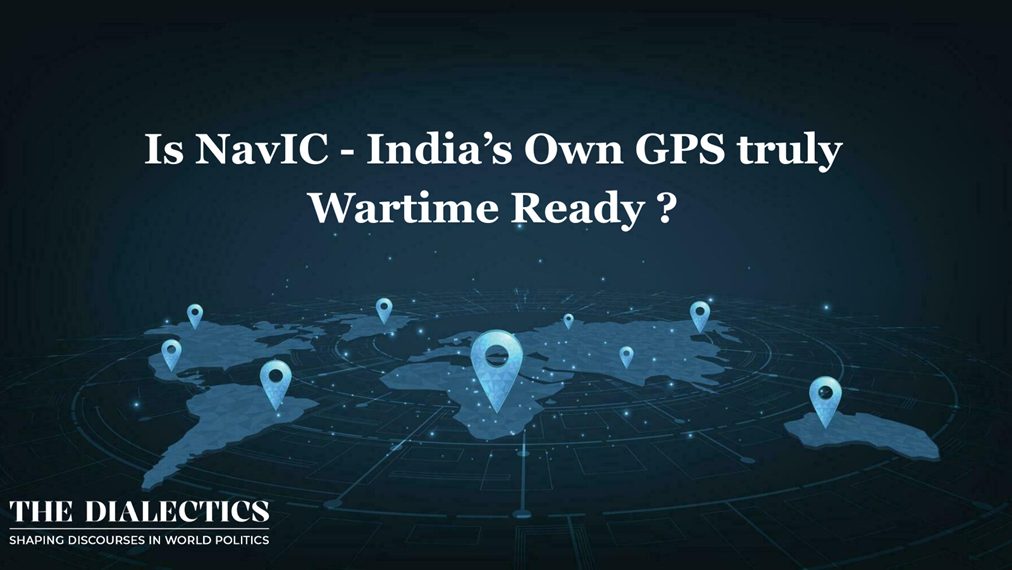In the modern era, critical technologies are an essential part of everyday life, and controlling these technologies gives a country an edge in leading the world in that particular field. Owning these critical technologies provides a state with a secure and reliable means to achieve its goals. Reliance on any other state over these technologies makes one vulnerable to the demands of the country supplying the technological services.
Simultaneously, it can potentially become a threat to the nation’s security and sovereignty. The use of drones and other modern technologies in warfare indicates how critical and sophisticated technological growth has become in contemporary times.
Role of GNSS in Modern Navigation
Global Navigation Satellite System (GNSS) is a term used to refer to any satellite based positioning system that can provide its services globally. The digital maps we use range from modern live location services to precision guidance of long-range weapons. In today’s world, the modern navigation system plays a critical role in the day-to-day lives ofevery individual, highlighting the importance of modern technologies in shaping the world discourse today. One of the most famous systems developed for this purpose was the Global Positioning System (GPS) by the USA. These are satellite constellation systems placed in Earth’s orbit that provide live Positioning, navigation and timing information.Being first developed by the USA, countries around the globe began to develop in this field of technology. While GPS has been widely used, the European Union has deployed its own constellation named Galileo. Similarly, we also have the Russian Federation, which has built its GLONASS constellation, and then there are the Chinese with their BeiDou Navigation system. These mentioned above are the four operational GNSS systems.
Global GNSS Systems and Strategic Independence
In the past, there have been several occasions where the USA has disrupted GPS to its advantage. Recently, during the 12-day war between Iran and Israel, we saw the decision of Iran to abandon the GPS and adopt China’s BeiDou Navigation Satellite system, as the Gulf has faced repeated disruptions of the GPS signal. This also indicates that today, the world has more options for access to GNSS, unlike in the past when the USA dominated this sector. Similarly, today every country aspires to be technologically independent and reduce dependency on other states, as is the case of India, where its growth today is acknowledged by people around the world, but what is the status of India’s own satellite-based Navigation system?
Origin and Development of India’s NavIC
For India, the lesson was learnt the hard way, as in 1999, the Indian military, upon request, was denied GPS data for the Kargil region by the US. This set in motion India’s aim to develop its indigenous satellite navigation system in order tomeet the positioning, navigation and timing requirements of the nation. Navigation with Indian Constellation (NavIC), also known as Indian Regional Navigation Satellite System (IRNSS), is the name of India’s Satellite constellation programme, indigenously developed by the Indian Space Research Organisation (ISRO) to meet the Positioning, Navigation and Timing requirements of the nation. It is designed with a network of ground stations operating 24*7, consisting of a precise timing facility, control centre, etc and a constellation of 7 satellites, out of which three are situated in the geostationary orbit and the other four are situated in inclined geosynchronous orbit. The NavIC offers two types of services, one for the civilian users known as Standard Positioning Service (SPS), which is also interoperable with other GNSS, and the other for strategic users known as Restricted Service (RS). The range of these systems covers the entire India and up to 1500 km from India’s borders. The first satellite, IRNSS-1A, 1A was launched in 2013, while the last of the 1st generation, IRNSS-1I, 1I was launched in 2018.
Current Status and Challenges of NavIC
To date, ISRO has launched 11 navigation satellites, out of which only four are fully operational today. The officials at ISRO have claimed that the required amount of data can be provided by four satellites. Of these four satellites, IRNSS-1B has already exceeded its life span of 10 years, while IRNSS-1F is almost about to complete its decade in service with a partial equipment failure. Over the years five satellites have faced a total failure of all three atomic clocks, inorder to replace its older fleet of satellites ISRO started launching the NVS series of Satellites. NVS which is meant to be a constellation of five satellites, it has already seen the launch of two satellites under this programme. NVS-01 was successfully launched in 2023, while NVS-02, which was launched in 2025, failed to reach its designated orbit, beingstuck in its initial orbit as the engine could not fire to lift it higher. With only four satellites functioning India’s NavIC system is on the verge of collapse give any failure in the currently functioning satellites. The Indian government has declared that three additional NVS satellites, NVS-03, 04 and 05, will be functioning before the end of 2026.
Future Prospects and Urgency for NavIC
With the 19-month delay between NVS-01 and NVS-02, will ISRO be able to complete the project given its ambitious deadline? The atomic clocks are a vital component of a navigation satellite, according to the officials of the ISRO. The newer generation of indigenously designed Rubidium-based atomic clocks has been facing procurement and technological challenges, which are slowing down the fleet of replacement satellites. The need to speed things up and overcome obstacles is crucial to make sure the IRNSS functions optimally since a failure would affect not only civilian life but also the abilities of the military, navy, and air forces of the nation during an emergency.




